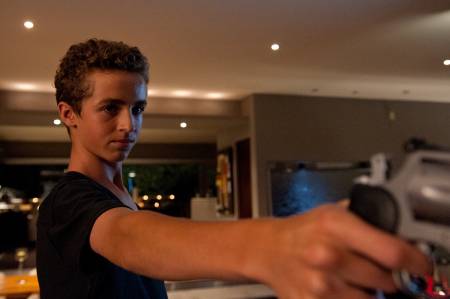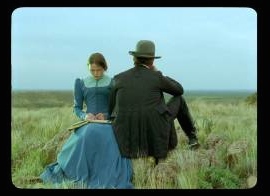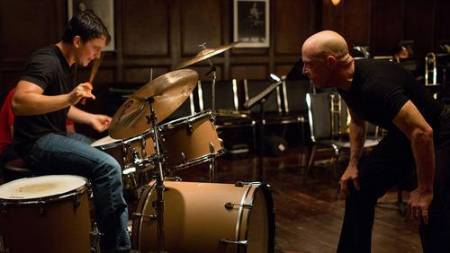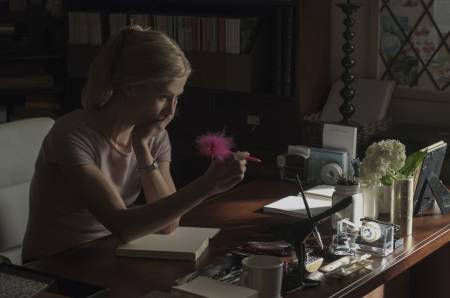-
Ossama Mohammed, Wiam Simav Bedirxan: SILVERED WATER, SYRIA SELF-PORTRAIT (2014)
OSSAMA MOHAMMED, WIAM SIMAV BEDIRXAN: SILVERED WATER, SYRIA SELF-PORTRAIT (2014)

In Homs Omar collects flowers and amid snipers in Silvered Water
Horrors of war in Syria from found footage and a Kurdish woman's camera
Silvered Water, Syrian Self-Portrait is a powerful film, and not for the squeamish, about the civil war in Syria. It's not a conventional documentary, of which a very fine one related to this subject is Talal Darki's Return to Homs (ND/NF 2014). It's a combination of horrific found footage, collected off social media by Syrian exile in Paris Ossama Mohammed, and foootage made in Homs by Wiam Simav Bedirxan, a young Kurdish woman who contacted Mohammed for advice on what to film around her. Mohammed has bonded the whole together with many subdivisions, in Arabic, and his own sometimes formal and poetic Arabic musings. The film is also edited to remind us constantly that much of the found footage (some of it could have come from Al Jazeera Arabic) was shot with cell phones, and that he and Wiam apparently were in touch with each other in live Facebook chats. We also hear her voice. The torture footage Mohammed shows one would like to forget. One can never forget Wiam's film journal, made during the Homs uprising when large segments of the city were destroyed and there was sniper fighting from building to building and street to street. Wiam's footage includes things one has never seen before. Girls who have lost many family members gathered in an impromptu "school" she started, where they smile and laugh. Cats wandering amid rubble with legs shot off, or faces burnt away. A little boy called Omar who has lost his father gathering flowers to place on his father's grave, talking to his father as if he were alive, walking with Wiam through the rubble and saying "We should not go that way: there is a sniper," then climbing a ladder to gather leaves.
For more detail, I recommend Jay Weissberg's sensitive and eloquent review for Variety from Cannes. I find Silvered Water leaves me speechless, the atrocities collected by Mohammed, the torture of youths, the killing and beating of protesters by government soldiers, hard to describe or comprehend. Return to Homs is perhaps easier to watch (though shocking and visceral too) because it tells a coherent story of a charismatic revolutionary leader. Mohammed's film creates a sense observing of the chaos and hell of war from a distance that can leave one feeling as helpless and depressed as he himself reportedly became after sifting through and editing his vernacular footage films from "1001 Syrians." As with Return to Homs, an understanding of Arabic, with its shifts from the formal and poetic to the colloquial and direct, will add substantially to the appreciation of the spoken narration.
Silvered Water, Syria Self-Portrait/ماء الفضة/maa' al-fiḍḍ,a, 92 mins., debuted at Cannes (Special Screenings). It was watched for this review in a press screening as part of the Spotlight on Documentary series of the 52nd New York Film Festival.
Arabic TV news item about the film's presentation at Cannes: https://www.youtube.com/watch?v=MwV2Tm7-VyQ.
Excerpt from the film and article in Arabic: http://www.alaraby.co.uk/miscellaneo...9-db3dfaa74a58
Last edited by Chris Knipp; 11-19-2014 at 11:34 PM.
-
David Cronenberg: MAPS TO THE STARS (2014)
DAVID CRONENBERG: MAPS TO THE STARS (2014)

Evan Bird in Maps to the Stars
"Maps" lacks a compass, moral or narrative
I don't think Evan Bird has anything to be ashamed of in future for his performance in Cronenberg's Maps to the Stars. He plays (with cool aplomb) a nasty little boy TV star who is also the son of a perverted couple, and his lost sister (played by an unappealing Mia Wasikowska) appears, and is temporarily hired as a "chore whore" (the charming term for a Hollywood dogbody/assistant) for the frustrated, declining star played by Marianne Moore. Moore received the Best Actress award at Cannes for this performance. But nonetheless it is a pathetic, melodramatic turn and one might wonder why she committed to it. Because the film was directed by Cronenberg, no doubt. Actors do not always know what they are getting into. Richard Pattinson plays a Hollywood limo driver who picks up Wasikowska when she arrives from Florida and then becomes involved with her. His chauffeur character is a naive would-be writer and would-be actor: the inside joke is that Cronenberg's previous film, a spot-on adaptation of Don DiLillo's Cosmopolis, starred Pattinson as a youg billionaire who rides in the back of a limo throughout. Pattinson brings charm and subtlety to his performance here. As Evan Bird and Wasikowska's mother and father, Olivia Williams and John Cusack are workmanlike. But that doesn't mean this glossy movie works.
All you can say when you watch Maps to the Stars is "What's the point of this?" The whole movie, whose plot is so nonsensical as to be puzzling, is a misstep. Everyone is egocentric and isolated, but so what? Though the production has a fine polish and the camerawork is smooth, Bruce Wagner's so-called "pitch-black Hollywood satire" has a moldy, pointless quality, despite being updated with references to iPads and "Mad Men." As a neurotic ronde, this pales to nothing much compared to P.T. Anderson's masterful Magnolia. As a busy Tinsel Town gossip film it can't match Altman's richly referential The Player. There's something off-key about the Canadian's sense of spoiled movie people. But most of all the problem is not in the direction but in the screenplay, which just doesn't hang together, doesn't make sense. The glitz is there, but not the meaning. The movie has no point, few laughs, and no narrative thrust. It leads through a serious of devious and nasty gestures, to several successively more violent acts, to a senseless and inexplicable ritual, and fizzles away.
The two main households, both palatial, cold modern -- a clear sign, as we know from Los Angeles Films Itself, that evil dwells therein, are indistinguishable: you barely know whose house you're in. That's a bad sign.
Bruce Wagner's previous effort to skewer L.A. is the lame Scenes from the Class Struggle in Beverly Hills (1989) -- another bad sign, a movie that in his Cannes review of Maps for The Dissolve Mike D'Angelo calls "dismally unfunny." According to D'Angelo, this screenplay actually dates from around the same time. If true, this explains why the whole concept seems out of sync, despite the contempo references. This is also the director's first film shot in the U.S. Like his curiously Classics Illustrated Jung-Freud film A Dangerous Method, Maps will no doubt make sense to some, but not to others. To me, it seemed off-key and inexplicable from the first scene. If for some reason the peculiar plot-line makes sense to you, you may enjoy the action, however crude its satire.
No matter: as Motherwell said of his paintings, the works that don't succeed are the necessary stepping-stones to the ones that do, and Cronenberg, a filmmaker of much daring and flexibililty, will live to map better stars another day.
Maps to the Stars, 99 mins., debuted at Cannes, and played at Toronto and other festivals, opening quickly along the way in various countries, including France 21 May (Allocine press rating a very good 3.7). It was screened for this review as part of the 52nd New York Film Festival. No US release date yet.
See also Bill Chambers' review: "time does not sharpen pop-culture commentary."
Last edited by Chris Knipp; 11-19-2014 at 11:33 PM.
-
Owen Moverman: TIME OUT OF MIND (2014)
OWEN MOVERMAN: TIME OUT OF MIND (2014)

Richard Gere, Ben Vereen in Time Out of Mind
How a star can go unrecognized: panhandling at Astor Place
As a director the accomplished Israel-born, New York resident movie writer Oren Moverman (he penned the script for the inventive Bob Dylan biography I'm Not There) had hitherto relied on aggressive performances by Woody Harrelson (in The Messenger and Rampart). He chooses a gentler star and a more vérité approach in Time Out of Mind, using the glamorous, sexy Richard Gere (who also produced) as a homeless person. It's stunt casting that in practical terms pays off. The homeless are so faceless Gere "auditioned" successfully by panhandling at Astor Place for forty minutes. Nobody gave him a cent and nobody recognized or really even saw him. Does Gere disappear into the role for us? Not quite. But there's a message in this performance: all homelessness is a reduction, a fall from the grace of a stable life. And there's no doubt Gere loses himself in the role, and in the street and shelter life his character is forced to live in the first scene, when a no-nonsense building manager (Steve Buscemi) throws him out of the trashed Brooklyn apartment an ex-girlfriend has been evicted from. From then on, George Hammond (Gere) is the victim of circumstance, striving merely to get food and drink (he has an alcohol problem) and some place to sleep.
Unlike the odd romantic couple of young New York street junkies in the Safdie brothers' Heaven Knows What, George is not part of a readymade street culture, but a newcomer. He is defensive every step of the way, trying to get back into any place he's kicked out of (including the initial apartment), and at first we think he's a regular guy who's fallen on sudden hard luck. Only later we realize that George in his own words is "just a fuck-up. Probably always was," has lived off various women for years, has had no job for years either, and is not even quite all there mentally.
While Moverman hardly develops a plot, Gere gradually builds a character -- out of nothing, because a clearcut backstory is studiously avoided. Time Out of Mind is a fine picture in its way. There is the old problem here of how you depict boredom and monotony without being boring and monotonous. George Hammond (Gere's character) has drunken afternoons and long nights on benches and in ER waiting rooms that bring distinctive longeurs for the viewer. Long subway rides don't have the benefit of our knowing the fugue will end as in the recent Asperger's boy drama Stand Clear of the Clsing Doors. Nor is there the complex plot that develops behind the homeless shelter meeting of father and son Robert De Niro and Paul Dano in Being Flynn. If there can be no back-story there can be no plot history: we must live in the moment -- the life struggling for daily survival forces on a person.
But there are scenes (encounters with a homeless woman played by Kyra Sedgwick who tells her story, a prolonged relationship with a homeless black jazzman played by Ben Vereen) that add considerable color, besides the documentary realism of depicting a number of nights at the old Bellevue, formerly the city mental hospital, now New York's biggest men's shelter, that provide milieu and human interest. Dixon (Vereen) is a motor-mouth. He becomes annoying (particularly to George) but is also a buddy for George and entertainment for us who brings humanity and laughs to a dreary survival scene. But George is on his own, as is most vividly depicted in his spacey encounters with the bureaucracy seeking to go from nowhere man and nobody to someone with an I.D., a birth certificate, and rights to public assistance. By now we know he needs it.
The movie is a constant battle between narrative and non-narrative elements, and this is a battle Moverman, whose script is based on a story by Jeffrey Caine, author of the film adaptation of John Le Carré's The Constant Gardener, finally surrenders to narrative. Story arc takes over when George's repeated brief encounters with his estranged daughter Maggie (Jena Malone) lead to a final hint of possible rapprochement. Moverman just couldn't leave his star completely out in the cold. In Time Out of Mind pros like Sedgwick, Vereen, Gere, Geraldine Hughes, and others blend into the documentary-style milieu, but things still tend to feel scripted, and, remembering the pleasure of Being Flynn's intricate narrative, one half wishes narrative had won out earlier here.
Time Out of Mind, 107 mins., debuted at Toronto. It was screened for this review as part of the 52nd New York Film Festival. At the post-screening Q&A, it emerged that the whole project was begun by Gere, who has long been involved with an organization to aid the homeless. Like the Safdie brothers' Heven Knows What (also in the 2014 NYFF Main Slate), this film is steeped in New York City atmosphere.
Opening in US theaters Wed., 9 September 2015.

RICHARD GERE @ P&I Q&A
[CK Photo]
Last edited by Chris Knipp; 09-07-2015 at 12:59 PM.
-
Lisandro Alonso: JAUJA (2014)
LISANDRO ALONSO: JAUJA (2014)

VILLBJORK AGGER MALLING, VIGGO MORTENSEN IN JAUJA
In Patagonia, chasing a wayward daughter
Scott Foundas points out in his Variety review that Lisandro Alonso's new feature, a costume piece set in the 1880's, contains more dialogue in its first reel than all of his preceding four films, but there is still a great deal of aimless and wordless wandering around by Viggo Mortensen in the rocky Patagonian wilds. And the words actually distract us, but only temporarily, from a less powerful narrative structure than Alonso provides in his masterful and haunting Los Muertos. There's nothing more satisfying and neat than when a single final shot caps off a film without words. It happens in Daniel Schechter's recent film of Elmore Leonard's Life of Crime, and it happens in Los Muertos. Jauja has a lot of fancy stuff at the end, but it doesn't satisfy. It begins with a Danish military engineer called Gunnar Dinesen (a homage to the glamorous writer-adventurer Karen Blixen's pseudonym, perhaps ). He's all dressed up in a fancy cavalry dress uniform and has the rank of Captain and he's supervising an engineering probject involving deep trenches. There's a very dicey local lieutenant with him, Pittaluga (Adrián Fondari) -- when first seen he's sitting in a pond masturbating, and a young soldier, Corto -- who is going to run off with Dineson's daughter Ingborg (Viilbjørk Malling Agger). Dinesen says she's fourteen. She looks older; maybe it's the 19th-century clothing. What is she doing there? Obviously, waiting for trouble. Dineson seems uncomfortable with the Argentinian men, as well he might be. Their talk hints of a genocidal campaign by the local military against the aboriginal population, whom they call "cabezas de coco" ("coconut-heads").
Jauja is in a nearly square format (full-frame 4:3 aspect ratio) with curved corners, which reminded me of Kelly Reichardt's Meek's Cutoff, a similarly formatted and similarly oddball avant-garde 19th-century western where people get lost. Meek's Cutoff has an ambiguous ending, but it does have an ending. I was hoping -- and it would have seemed Alonso-ish, and true to the way this film was going -- if Jauja had had a totally bleak ending à la Paul Bowles, where a white man winds up up shit's creek without a paddle, like the linguistics professor in "A Distant Episode" who is badly beaten and gets his tongue cut out and is chased away with tin cans tied to his ass. Instead Alonso settles for a fairy-tale meeting with an old Danish woman (Ghita Nørby) living in a cave (but we're still in Patagonia), with a mumbo-jumbo confab confusing whether the old lady is Dineson's mother or his daughter, and he's led there by a lean scruffy dog that rises from another pond, seen from behind and motionless, appearing like a sphinx. That's a stunning visual trick, and clearly Alonso and his dp (the Finn, Aki Kaurismäki's cameraman Timo Salminen) can do striking, sometimes gorgeous things with images here when they choose, apart from the forbidding, lunar beauty of the Patagonian landscape itself.
And then we inexplicably leap forward to the present day, to a totally different but pretty and summery landscape, a fabulous castle in Denmark World of Interiors must be drooling to do an article on, and a bedroom where a very pretty young girl (prettier than Dineson's daughter by a mile), waking up and going outside to the sun-dappled lawn and garden, finds a little toy soldier that had been in the hands of Ingeborg. What's it mean? You've got me. The only link between the Patagonia finale and the tacked-on Denmark one is dogs, and the toy. (A dog is probably Ingeborg's avatar; she asks for a dog in her first dialogue with her father.)
Jauja is a polarizing puzzle picture, a dazzler and a snooze young cinephiles and Alonzoites can enthuse over and debate the meaning of. For others it's just an annoying head-scratcher, a waste of 108 minutes of our time. Yes, maybe as Noel Murray said in his Dissolve summary, "Alonso’s style reaches new heights of sensory attentiveness and physicality" in Jauja, but this film's elaboration loses the magic and mermerizing sotrytelling the director achieved earlier with much simpler means. He seems in danger of the same hubris and hermeticism that have led astray that other young Latin American master, Carlos Reygadas. But fans of auteur boldness must watch each new film by either for the times when that doesn't happen and something amazing emerges. Even misfires are not to be missed.

JAUJA STILL SHOWING ACTUAL FILM FORMAT
Jauja premiered in Un Certain Regard at the Cannes Film Festival, where it won the FIPRESCI Award. It’s also an official selection of the Toronto and New York Film Festivals. Screened for this review at the NYFF, where Alonso has been named this year's filmmaker in residence. Jauja will will open theatrically in the US 20 March 2015 (limited); in the UK 10 April; in France 25 April.
Last edited by Chris Knipp; 03-17-2015 at 05:20 PM.
-
Damien Chazelle: WHIPLASH (2014)
DAMIEN CHAZELLE: WHIPLASH (2014)

MILES TELLER and J.K. SIMMONS IN WHIPLASH
Suffering for their art: a sadistic music teacher
The 29-year-old Damien Chazelle's simple, effective, technically savvy second feature (his first was the 2009 Guy and Madeline on a Park Bench) is so zippy with its slam-bang editing and shocker moments it goes right through you, but then maybe after an hour or so you may question some of its powerful effects. Would a modern day music teacher at a New York conservatory something like Juliard smack a pupil repeatedly hard on the face in front of several dozen other students and throw a chair at him? Would he repeatedly yell homophobic epithets at the whole band at every session? Would a student playing with a band at the JVC Jazz Festival steal a very prolonged solo when it's only by chance and at the last minute that he's been included in the show? These things, I guess, are not meant to be taken literally. Chazelle, who has based his screenplay (loosely, we hope) on experience of a severe music teacher in his own high school, is exaggerating to get his points across and to make us think. But with things screwed up to such a pitch as this, can we think?
Anyway, Whiplash, the name of a band composition (featured in the film) that Chazelle hated because its rapid tempo changes are a drummer's nightmare, poses the question: is brutality necessary to bring out musical genius? The filmmaker and crew tossed around the phrase "Full Metal Jacket at Julliard" during the (brutally short) 19-day shoot. Simmons is like the sergeant featured in Kubrick's movie. With his gnarly, muscular body, shaved head and aggressive voice all he needs is a training field and a uniform to evoke the tests and humiliations of combat training. In other ways this is like a conventional sports movie, with the thrills of victory and agonies of defeat leading up to a grand finale when the goal is achieved against all obstacles. Chazelle simplifies and overdoes everything, but does so with such a sure touch and with such economy that it all works brilliantly. And J.K. Simmons as Terence Fletcher, the morally dubious but efficaciously sadistic instructor, and Miles Teller, as Andrew Neyman, the ambitious fledgling drummer, play their respective parts with impressive assurance.
Andrew is a newbie at the Schafer School. His passion is to become a great drummer worthy of comparison with Buddy Rich, whose solos he studies. (Chazelle doesn't reference subtler greats like Art Blakey and Max Roach: Andrew wants to be a showoff.) Everyone is afraid of Terence Fletcher but wants to study with him and please him. Ironically, he repeatedly tells Andrew and the band to have "fun." Mostly, Andrew's practice and his sessions with Fletcher lead to bloody hands, exhaustion, and a body drenched in sweat. Where's the "fun"? In masochism? Fletcher tells Andrew that Charlie Parker was inspired to try harder and become a transcendently great saxophonist by having a cymbal thrown at him and being kicked off the stage. Would he really not have become the "Bird" without that humiliation? Is "good job" really the worst thing you can tell a beginner, as Fletcher says?
The brutality of Fletcher's teaching works well, visually at least, for drumming, when the player is beating on his instrument. To help a classical pianist or a violinist one might need a more gentle hand, such as that of the octogenarian New York teacher Seymour Bernstein, chronicled in Ethan Hawke's new documentary Seymour: An Introduction. From watching Seymur we learn things about fingering, selecting the best Steinway, posture, modulation of sound levels. In Whiplash, we don't learn many specific details about music beyond that it involves tempos and bars, and that a musician can spoil the sound of an ensemble by playing off key. (We already knew that.) Since this film is all about Andrew and his ruthless, lonely struggle, there's not much sense of the social life at the school, if there is any.
Other things are skewed or exaggerated. Andrew's desire to be on time for a performance leads him to pull himself together after an event that should have left him in the hospital. And yet this effort only brings about the dismissal from Fletcher, "You're done!" Andrew is so obsessed with his music that he breaks off a realationship with a girl (Melissa Benoist) that he has barely begun. To show that most of the world's population, in the relentless view of those who pursue excellence, is mediocre, Andrew's dad is branded as an amiable loser, a a would-be writer who has wound up teaching high school and munching popcorn and M&M's while watching movies with his son.
Whiplash, whose unrolling appropriately shows a precise sense of timing, is full of music, and most of the musicians are real ones. Simmons studied conducting at one time. Miles Teller, a fluid and confident young actor who came to the movie with experience as a rock drummer, shows both deftness and commitment in his depiction of Andrew's many and grueling drum sessions, which finally end in pleasure and triumph. But just as an arts or music student must apparently endure pain and sacrifice and even humiliation on the way to accomplishment, Whiplash sacrifices subtlety and nuance in the interests of presenting its moral dilemma with brutal theatrical effectiveness. It works, but at a cost. Nonetheless it is turning up on many annual best lists, and Simmons is sure to get a deserved Best Supporting Oscar nomination.
Whiplash, 105 mins., debuted at Sundance, and was made with Sundance assistance based on a short film that previewed the subject. It has shown at other festivals including Toronto and was screened for this review as part of the 32nd New York Film Festival. US theatrical release began 10 October and reviews have been raves (Metacritic 88%).
__________________
Whiplash, 105 mins., debuted at Sundance, and was made with Sundance assistance based on a short film that previewed the subject. It has shown at other festivals including Toronto and was screened for this review as part of the 32nd New York Film Festival. US theatrical release began 10 October and reviews have been raves (Metacritic 88%).
Last edited by Chris Knipp; 08-26-2021 at 06:45 PM.
-
David Fincher: GONE GIRL (2014)
DAVID FINCHER: GONE GIRL (2014)

ROSAMUND PIKE IN GONE GIRL
Tidy chaos: David Fincher's skillful blend of murder, deception, living in public, and hiding everything
David Fincher's fascination with America's criminal underbelly and domestic deception makes for a richly detailed and constantly entertaining mystery thriller in his adaptation of Gillian Flynn's 2012 bestseller. What an elaborate, precision twittering machine this movie is! And it blends the director's fascination with police investigation explored in Se7en, Zodiac, and The Girl with the Dragon Tattoo, with more about the media circus' invasion of US bedrooms. This is rich, juicy schlock that, as Eric Kohn said on Twitter, in other hands might be "super campy or super trashy," but in Fincher's becomes classic Hollywood cinema. Underpinning it all is a complicated but tightly constructed screenplay by Flynn herself with a back-and-forth timeline and an overlapping narrative full of jaw-dropping revelations. This is a big movie with an original and well-chosen cast headlined by Ben Affleck (stepping back from his directorial role again after his Oscar for Argo last year) as NIck Dunne, gem-like Brit Rosamund Pike as his ice-queen wife Amy who disappears, Carrie Coon as Nick's comradely twin sister Margo, Kim Dickens as Detective Rhonda Boney, Tyler Perry as ace criminal lawyer Tanner Bolt, and Neil Patrick Harris as Amy’s creepy and rich one-time beau Desi Collins.
The plot is a borderline indigestible mix of material from horror, noir, mystery story trickery, and Fox News scandal-mongering that is both preposterous and absolutely true to life. Fincher, Flynn, and the well-managed cast conspire to make it all clear and fun. We can't tell too much: like the post-Fourth of July wedding anniversary puzzle treasure hunt Amy constructs for Nick (and for the police and the public) to hide-reveal her plotting, this movie's a game of hide-and-seek and gradual pop-up revelations. But we begin with the day of Nick and Amy's fifth wedding anniversary. Nick returns to the couple's rented McMansion from a walk to find a living room coffee table smashed and Amy missing. He calls the police. And the story, in its various versions, begins getting told, first from Nick's and the public's point of view, and later on in the film from Amy's. When we get to Amy's, the dateline chronology starts back all over again. Flynn just uses a grab bag of old familiar thriller tricks, but they work. This becomes an inventive variation on the mystery story's final revelations of what really happened that instead of being poured out at the end, is, for maximum pleasure, spread all through. When Fincher, in discussing the film, mentions that he thought of Desi as sort of like Claire Quilty in Lolita, you realize Nabokov might have indeed liked the ironic complexity of Gone Girl.
Amy, however, isn't Nabokov's kind of girl. We don't know who or what she is; she doesn't either. Her life has been warped by growing up with a mother who used her girlish experiences as fodder for "Amazing Amy," a highly successful and lucrative children's and young adult's book series, cannibalizing and improving upon the things she did, so her "reality" (a word Nabokov scorned) was a flimsy simulacrum of her mother's profitable fantasies. When Nick and Amy meet (in flashbacks) it's all romantic playacting and pledges always to be honest. Their married life is nothing but lies, a neurotic nightmare. Both are writers in New York when they meet, but soon after they marry they lose their jobs; and when Nick's mom gets fatally ill, they move back to Missouri and use her trust fund. But money runs low because Amy's mother's book sales dwindle, her parents are strapped, and teaching and running a bar aren't bringing in a lot of dough for the now increasingly unfun couple.
As the police investigation proceeds, suspicion falls more and more on Nick; the disappearance seems faked. There is a public "find Amy" initiative that feels a little like a political campaign, with Nick a very iffy candidate. Tidbits from a diary kept by Amy are constantly flashed at the audience, contrasting with Nick's completely different versions of the marriage. And then we finally get to what was actually going on with Amy when she disappeared, and after.
Gone Girl is destined to be popular and critically acclaimed movie, and by no means undeservedly: I've hardly begun to describe its many pleasures. It's sure to emerge as one of the best American films of the year. But in general I am an occasional David Fincher admirer rather than a big fan and that remains true here. His Zodiac is a remarkable piece of precise cinematic obsessiveness. But only when he united with Aaron Sorkin for the much more brightly lit and smarter The Social Network did he provide me with unmitigated and total pleasure. Though Gone Girl, despite its indulgent two-and-a-half-hour length, is very enjoyable to watch, I'd have preferred something more pared down and film noir-ish. This is too much of a muchness. In particular it works the media circus theme too hard. The way Fincher juggles everything is impressive. But then juggling is just an act. What you'll most remember is the dark heart of this warped, strange woman, which Pike chillingly evokes, and her husband's appealing but cheesy good-old-boy machismo, which Affleck comfortably embodies -- and the frightening prospect of the two of them together in that house.
Gone Girl, 150 mins., had its world premiere 26 September 2014 as the opening night film of the New York Film Festival, where it was screened for this review. A glowing review appeared 11 days earlier by Justin Chang in Variety. Worldwide release by Fox is set for 2 October, 3 October in the US, days later in some countries (8 October in France).
Last edited by Chris Knipp; 08-26-2021 at 06:22 PM.
-
Mathieu Amalric: THE BLUE ROOM (2014)
MATHIEU AMALRIC: THE BLUE ROOM (2014)

LÉA DRUCKER, MATHIEU AMALRIC IN THE BLUE ROOM
A chilly, claustrophobic Simenon adaptation
The French actor Mathieu Amalric is so busy, active, and good (with 92 current thespian credits) it's hard to see why he even bothers to try his hand at directing, but his (reportedly) pretty faithful adaptation of the eponymous Georges Simenon short crime novel is his fourth time as réalisateur. And while his previous, On Tour/La tournée (SFIFF 2011) was a big long blowsy ensemble piece The Blue Room/La chambre bleu is as tight and economical as you could imagine. And it has pleasures, in its claustrophobic 1.33:1 aspect ratio images shot brightly with a fine eye for composition by Christophe Beaucarne; in its sometimes Bernard Hermann-esque use of Ravel in Gregoire Hetzel's movie music; in the clinical precision of the fussy investigating magistrate/juge d'instruction -- because this is a crime, in fact a murder, story -- played with pale obsessiveness by Laurent Poitrenaux. But in this short 76-minute quickie production (shot in three weeks, with the director costarring) there's the feel of a rapid exercise by a crack crew who, however, could just as well have been doing something else. Despite the neatness and elegance -- and in its way this is a brilliant shattered-mirror puzzle-piece -- something gets lost: what's meant to be an erotic thriller with strong sexual and emotional content comes out in Amalric's version as fragmented set of memories intercut with a police procedural. The two are neatly intertwined. But the film is uninvolving in the stingy way it unreels its mysteries.
If it ever does: one may walk out wondering what actually happens. Amalric pares down the story to action elements and the wild passion gets lost. As Guy Lodge puts it in his Variety review, Amalric has adapted "Georges Simenon’s slender mystery novella with fidelity to its bleak narrative but indifference to its disquieting erotic and psychological subtext." The effect, despite a crack crew at work on the film, feels chilly and academic, though in its French release Blue Room got excellent reviews (AlloCiné press rating 3.9).
What does happen? We begin with a pair of childhood friends who've been suddenly reunited as adulterous lovers, Julien Gahyde (Amaric), a married local businessman involved with agricultural equipment, and Esther Despierre (Stéphanie Cléau), wife of a pharmacist who's not at all well. When they're seen early on in the titular Blue Room of a travelers' hotel that's the site of their several months of trysts (only briefly shown), she says something telling to him: "If I were suddenly free, could you free yourself too?" He's typically noncommittal, but obviously not only Esther's pharmacist husband but Julien's wife Delphine (Léa Drucker) is in the way of their love (if he cares).
We get it. But from then on, in the busy account via memories and elaborately documented questioning by the examining magistrate, it gradually emerges what happened, except that Esther and Julien are rarely seen together again except wearing handcuffs, and Julien hardly says anything. Did he do anything, and if so does he know what he did? Definite possibilities only emerge toward the end, though it's soon clear Stéphanie is suspected of poisoning her husband while the town doctor is away and making it look like heart failure. As Guy Lodge points out, in general the setting is updated, but some elements from the 1964 book, notably the crucial role played by letters, are out of sync with today.
The Blue Room/La Chambre bleue, 76 mins., debuted at Cannes in the Un Certain Regard category. French theatrical release the next day 17 May 2014 with fine reviews, as noted. Various other festivals, including the 52nd New York Film Festival, as part of which it was screened for this review. US release 3 October.

AMALRIC @Q&A [CK Photo]
Last edited by Chris Knipp; 11-19-2014 at 11:28 PM.
 Posting Permissions
Posting Permissions
- You may not post new threads
- You may not post replies
- You may not post attachments
- You may not edit your posts
-
Forum Rules





 Reply With Quote
Reply With Quote









Bookmarks